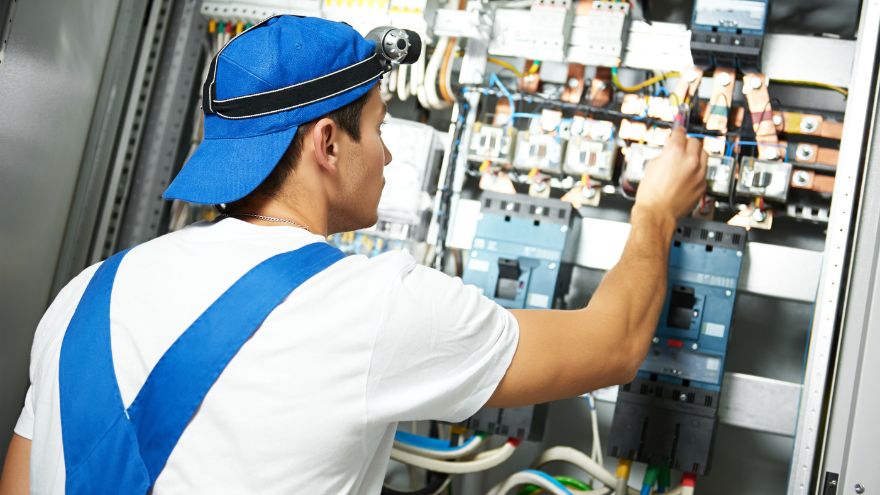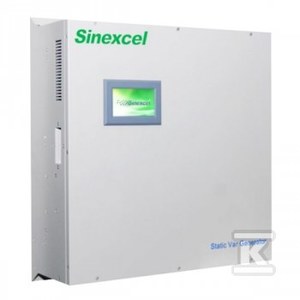Active energy is converted into useful work and heat losses, while reactive energy pulsates between the energy source and the receiver. It is necessary for the proper operation of receivers. However, its excess is unfavorable and results in additional costs. What exactly is reactive energy and what is an SVG active reactive power compensator ? You can read about it in this article.

Check out reactive power compensators at the Onninen wholesaler
What is the division of reactive power?
 Reactive power is divided into two types: inductive and capacitive. The former is taken from the power grid and is necessary to create a magnetic field in motors, transformers or chokes. These devices need a magnetic field to maintain the conditions necessary to perform work. In turn, capacitive reactive power is transferred to the power grid through various types of receivers, e.g. lighting fixtures.
Reactive power is divided into two types: inductive and capacitive. The former is taken from the power grid and is necessary to create a magnetic field in motors, transformers or chokes. These devices need a magnetic field to maintain the conditions necessary to perform work. In turn, capacitive reactive power is transferred to the power grid through various types of receivers, e.g. lighting fixtures.
Although the presence of reactive power is necessary, it often increases the frequency of power grid failures because it causes voltage drops in power lines and transformers.
What are the legal limits on reactive power?
Legal regulations limit the amount of reactive power consumed. The key factor in this case is the tg ∅ coefficient, which determines the ratio of inductive reactive power to active power. Exceeding the value of 0.4 results in financial penalties charged by distribution system operators. Electricity distributors also charge fees for introducing capacitive reactive energy and too high volumes of inductive reactive energy into the network.
What is reactive power compensation?
Reactive power compensation involves identifying its source and selecting an appropriate solution that will compensate it. Devices that generate reactive power should be installed near the receivers, which means that there is no need to transport it through the power grid. To compensate for inductive reactive power, capacitor banks and reactive power compensators are used, and to compensate for capacitive reactive power, inductive choke batteries are used. Thanks to the use of compensation devices, the amount of reactive energy consumed from the network is limited and the possibility of exceeding the permitted value of the tg ∅ coefficient is eliminated.
What can you gain with a reactive power compensator?
In the case of capacitive reactive power  any collection thereof is treated as extra-contractual and is immediately associated with charging fees. Costs related to reactive power consumption exceeding the contractual limit may, in some cases, constitute 1/3 of the value of the monthly electricity invoice. The use of appropriate devices that compensate for the reactive power consumed reduces this fee to zero.
any collection thereof is treated as extra-contractual and is immediately associated with charging fees. Costs related to reactive power consumption exceeding the contractual limit may, in some cases, constitute 1/3 of the value of the monthly electricity invoice. The use of appropriate devices that compensate for the reactive power consumed reduces this fee to zero.
Until recently, fees for reactive energy were almost exclusively borne by medium and large consumers. Today, the development of modern energy meters (which, in addition to active energy, also count reactive energy) means that the costs related to passive energy are also borne by small companies, public institutions and municipal plants.
Compensating for reactive power:
- we will reduce electricity bills in the company
- we will reduce the excessive consumption of passive energy
- we will stabilize the operation of the power system
What is an SVG active reactive power compensator?
 The SVG active reactive power compensator is a power electronic device whose task is to compensate inductive and capacitive reactive power using one module. Fast response, below 10 ms, to dynamic changes in the cos (φ) value ensures absolute maintenance of the set power factor parameter, individually in each phase, and limits the flickering of light caused by dynamic changes in the reactive power load. In alternative devices, such as capacitor banks, the response time ranges from several to several dozen seconds.
The SVG active reactive power compensator is a power electronic device whose task is to compensate inductive and capacitive reactive power using one module. Fast response, below 10 ms, to dynamic changes in the cos (φ) value ensures absolute maintenance of the set power factor parameter, individually in each phase, and limits the flickering of light caused by dynamic changes in the reactive power load. In alternative devices, such as capacitor banks, the response time ranges from several to several dozen seconds.
In the active compensator, advanced control algorithms protect the device against overloads and eliminate the occurrence of current resonance. The modular structure allows for very quick and convenient expansion if the power demand increases. The SVG compensator display allows you to parameterize the device, view network, compensator and load parameters. The HMI panel has a built-in memory for up to 500 recorded events (logs). Additionally, on the display you can view current and voltage waveforms as well as the values of basic parameters and the quality of electricity such as: Active, reactive and apparent power, Cosφ, RMS value of voltages and currents, current value in the neutral wire, THDI, THDU, spectrum of current and voltage harmonics , the temperature of the IGBT transistor.
SVG reactive power compensators in the Onninen wholesaler
- One of the compensating devices
 reactive power in the range of 10-200 kVar is the active reactive power compensator SVG 010. The compensator can be expanded to 8 modules. The small dimensions of the device enable easy installation even in places with limited space. It is an ideal solution for power systems that require effective and flexible reactive power compensation.
reactive power in the range of 10-200 kVar is the active reactive power compensator SVG 010. The compensator can be expanded to 8 modules. The small dimensions of the device enable easy installation even in places with limited space. It is an ideal solution for power systems that require effective and flexible reactive power compensation. - Another solution will be the SVG 015 active reactive power compensator, offering smooth reactive power regulation. Wall and rack versions available for flexible installation. Stepless reactive power compensation allows for precise adaptation to changing conditions. It is a versatile compensator that effectively supports the stability and efficiency of electrical power systems.
- When it comes to the SVG30 active reactive power compensator with a fast response time of less than 15 ms. Thanks to the 3-level IGBT driver topology, it provides precise control of reactive power. Switching frequency up to 20 kHz minimizes energy losses and increases work efficiency. The optional 4.3" HMI control panel or Wi-Fi module enables convenient monitoring and control. The possibility of parallel connection of modules allows for expansion of the reactive power compensation system.
- SVG 050 Active reactive power compensator offers the option of a 7" control panel enabling data saving and export to an external USB drive. The compensator control panel also enables generating weekly, monthly and current reports from recorded parameters, changing the data aggregation interval and exporting them. Additionally, the ASVG type This active compensator enables filtering of current harmonics of the orders H3, H5, H7, H9, H11 and H13, which allows eliminating interference and improving the quality of the power supply.
Check out reactive power compensators at the Onninen wholesaler